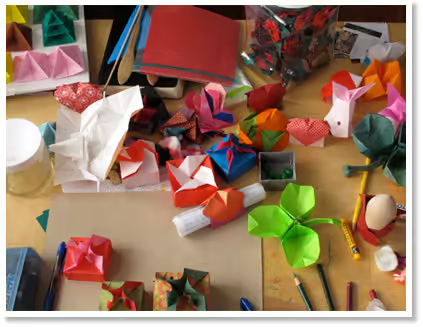I love the creative potential of a “clean slate”. An annual ritual of mine is to begin the year with a tidy worktable. Of course just as I’ve finished organizing my studio and put everything in its place, a new project appears. Soon enough there is a blizzard of papers and materials flying all over the place and chaos reigns again!
The creative possibilities of chaos are a thrill too. Looking at the clutter on my table in the morning, with rested and fresh eyes, I’m offered an open invitation to explore, to make new connections, to see new patterns and to dive into my work.
To me, it’s important to let creativity surface in an organic way both on my table, and in the other areas of my life. My ideal is to let the creative impulse take me wherever it might, regardless of what I’ve accomplished previously.
As the year advances, I find myself passing through cycles of chaos and order, and I’ve learned to enjoy them both.
In 2011 I documented these cyclic changes by taking periodic photographs of my workspace. Here is my visual journal shown on a short video.
“In all chaos there is a cosmos, in all disorder a secret order.”
~ Carl Jung
—————
Complete List of Visual Journals:
- A year’s Journal -Leyla’s Origami Worktable 2015
- Fun and Inspiration from My Creative Origami Table -2014
- Why Keep a Journal -Creativity Through Origami -2013
- Keeping a Visual Journal –Leyla’s Work Table -2012
. . . . . . . . . .
If you like what you find here on Origami Spirit, click to subscribe
for upcoming posts notifications –It’s easy and FREE!
. . . . . . . . . .


I really gotta show this video to my mom to prove that I am not the “only person who likes origami as much as this”! She keeps on telling me to clear my computer desk free of origami n it’s either I keep telling her “Mom, please let me keep them!” or i just stuff them all on the top bunk of my bunk bed which nobody uses except me. Now, I am even stuffing them in my closet! You just can’t stop old habits!
Leyla –
Thank you for posting this thought – provoking piece. Having followed your blog with great pleasure through the year, it is fascinating to see this overview, seeing the light change through the seasons, seeing different folds appear throughout the year (hearts for Valentine’s day, stars as Christmas approaches), seeing the papers you use, the books you refer to – and above all the importance of your journal that, literally and metaphorically, is central to your work. I particularly enjoy the way in which you will fold many versions of a model in different colours, and for presentation on your blog. I am often struck by the way in which multiple folds have an eloquence of their own, much more than the sum of their parts, and by the way in which I want repeatedly to fold even the simplest piece which I have just learned (at the moment it is the Alice Gray dove). These things, for me, go to the heart of origami, its ability to charm, to restore and to enliven the spirit.
Hi Mark, I am glad you have enjoyed my blog and this post in particular.
I share your thoughts on folding a model repeatedly… a while ago I referred to repetition in one of my posts.
Here is the link: http://thebraid.wordpress.com/2008/01/13/the-power-of-repetition/
Thank you for sharing your impressions so beautifully written.
Thank you Leyla.
I also recall a remark from a teacher that when a child learns to fold a model, they will fold it hundreds of times. When an adult learns to fold a model, they will fold it once then move on to something new. I think this is a valuable insight which accords exactly with what you have written about the way in which repetition soothes the mind whilst, at the same time, sharpening the understanding. It also goes to the child – like sense of wonder that, at its best, origami gives us, and which we lose at our peril.
“…when a child learns to fold a model, they will fold it hundreds of times. When an adult learns to fold a model, they will fold it once then move on to something new.”
A remark like this is reassuring for me… it means that I have not lost my child-like sense of wonder! ;-)
There are models that I tent to fold repeatedly more than others. Perhaps those whose folding sequence is elegant and the result is striking, for example Roman’s cardinal or Maria’s rose box. Something too complex I might fold for the sake of studying it, but I rarely make it too many times.
What about you? What are the characteristics of models that you tend to fold several times?
Looks just like my work area; however, I wouldn’t want it any other way. Our hands are never idle are they?
Great article, Leyla and I love Jung’s quote.
Yes Rosemary, our hands are always busy… I think of the miracle of having hands and what they can do, feel and express!